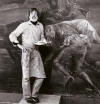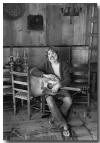| Friends Of The Little Bighorn Battlefield |
The Next Generation In The Study Of Custer's Last Stand |
Eric von Schmidt |
| • The Battle • Archeology • Memorials • Little Bighorn Store • News • Book Reviews |
Eric von Schmidt Painting "Storming of the Alamo"Photo copyright George R. JanecekThe creator of the painting, "Here Fell Custer" which is seen at the top of every page on this website passed away February 2, 2007. I’ve been reading the countless obituaries from all over the world for Eric von Schmidt. The Associated Press released one and it was printed in every major newspaper. Many other news outlets wrote their own, and reported the news of his death on NPR. All these obituaries had one thing in common: they focused on the music career of Eric and mostly ignored his talent as one of America’s best historical artist. All of them missed telling the readers what Eric was like as a human being. I’ve pondered for days whether to write something about Eric because his death has been difficult for me. Maybe I have been in denial. After reading these many stories written by people who didn’t know him, though, I feel I should. As I write this I am looking at a fax of a photo of a bearded man wearing eyeglasses laid out on his back. Protruding from his chest is an arrow and another has pierced his stomach. The man is Eric and he is lying in this position while in front of his epic painting “Here Fell Custer.” He had this photo taken the day he finished the painting; after five years of working on this painting Eric showed his friends just how funny he could be. I had only known Eric since 2003; however, during that time he and I developed a fast friendship. We were more like father and son. We shared episodes in our lives that we saved for only those close to each other, which resulted in him calling me Grizz and I calling him Crow Dreamer. He gave me a print of “Storming of the Alamo” and inscribed it to Grizzly from Crow Dreamer. This friendship grew from only one form of communication: fax. Due to throat cancer, Eric lost his vocal cords a few years before we met, and had to let go of his musical career. He didn’t own a computer and because he could not talk on the phone, he made all outside contacts by fax. His doctor’s appointments were by fax, and he contacted family and friends by fax. We became friends through this ancient technology. It was strange at first, for me, but not Eric. I tried to convince Eric to get a computer. I explained to him how much easier life would be with one; he could email, he could fax, he could even instant message friends. Eric had no concept of what I was trying to teach him. But, he tried. He bought a Mac. I could almost see him yelling at the machine (yes, he was temperamental) for not cooperating in its set-up. A musician friend helped Eric install it and showed him the ropes. She set up his internet and email account. The first test was to send me an email. YES!! It worked! I quickly sent one back and suggested how easy it would be to write back by just clicking on the reply button. He did. I was elated that I might have contributed to improving Eric’s ability to communicate. However, the next day my fax machine started buzzing. It was from Eric of course; and he was pissed. He couldn’t get the idea of this computer thing straight. I tried to encourage him, but over time the Mac collected dust in the corner of his small home. Actually, it was his father’s (Harold von Schmidt's) old studio that Eric called home. The house where Eric grew up was across the yard on the same property. Eric called it the Big House. He preferred renting it out and was totally comfortable living in the studio. Eric’s daughter, Caitlin von Schmidt, would eventually move into the Big House to take care of her father. Photo copyright Marc PeloquinThe obituaries didn’t explain how funny Eric could be, or how temperamental he could become (usually when he was frustrated with his lack of communication), or how generous he was. Eric shared his music, his art, and his time to help people achieve their goals in art or music. I’m also sad because Eric and I never met face-to-face, not even after we developed this close relationship. We had plans for me to travel to Westport to spend a few days with Eric. We planned to talk about history, music, film, and further plans for the website we were building to show his and his father’s art. That trip never came to pass because of his failing health. Eric had finished his battle with throat cancer before we met; however, he was in the middle of fighting Lyme disease when we first started faxing each other. Eric told me that it was a much harder fight than the cancer. Even when the doctors finally concluded that the Lyme disease was beat, I’m not sure it really was. Like Malaria, Lyme disease seems to come and go, and when you’re a man in your 70s, that coming and going might be more like coming. In time Eric broke an ankle, and not long after -- and probably as a result -- fell and broke a hip. Eric endured a successful hip replacement surgery and was working through rehab when he suffered a stroke in August 2006. With all that, Eric never suggested he would ever quit painting. I encouraged him to take up another historical subject like the Alamo and Custer for his next masterpiece. I suggested his subject have something to do with Lewis and Clark and the Corps of Discovery since our country was beginning its centennial celebration of that expedition. Eric loved the idea. Eric painting "Storming of the Alamo" in Utah -- photo courtesy George JanecekHe and I threw out several ideas of what the painting’s subject should be before he decided the painting would cover the first official meeting between the Corps and Shoshone. It was perfect and it was full of drama. Eric immediately bought the canvas and started sketching ideas. It was during times like Eric painting Lewis and Clark that I saw him at his best and at his happiest. Anyone recovering from ill health has good and bad days. I knew when Eric was going through a bad day; that was when the fax machine was quiet. If it was quiet more than a few days, I began to worry. I finally grew tired of worrying and asked Eric if he could give me relatives' names and contact information, which he shared gladly. I pictured Eric on the floor of his studio needing help. He understood. During the winter of 2004 the fax machine went completely quiet for days. I contacted Eric’s daughter Caitlin by email. Her response came back that Eric had been in the hospital and that he would be fine. She had decided to move into the Big House, though, in order to take care of him. That came as a sense of relief to me, knowing Eric would not be alone. In the meantime, as Eric’s representative for his artwork, I managed to publish “Ballad of Lewis and Clark” in the April 2004 issue of “Wild West” magazine and August 2005 issue of “Smithsonian.” “Smithsonian” didn’t publish a foldout version of the painting as they did for “Here Fell Custer” in 1976 and “Storming of the Alamo” in 1986, which was somewhat of a disappointment; however, those issues ensured Eric’s audience that he was still kicking. During this period Eric saw "Here Fell Custer" make the cover of the University of Oklahoma Press reissue of the classic book, Bugles in the Afternoon. "Here Fell Custer" and "Storming of the Alamo" were also seen on the History Channel. Eric and Caitlin -- photo courtesy Caitlin von SchmidtThe fax machine went completely quiet around the holidays of 2005; that is when things began to turn for the worst for Eric. Broken bones, long hospital stays, and then the stroke in August 2006. My only form of communication was through Caitlin. I can’t thank her enough for taking the time she did to keep me informed of Eric’s challenges. Eric spent more time in hospitals and rehabilitation centers than at home over his last year. Caitlin would read get well wishes to him and post them on the walls wherever Eric might be so he could be reminded at anytime how much people were rooting for him to get better. The fax machine no longer buzzes with messages from Eric. I remember Eric as one of the most giving human beings I have ever known. He gave from his heart and his soul. He also gave treasures from his life to his friends. These I now keep close. They mean so much to me, and they remind me everyday how thankful I am that I knew this man. God Bless You Eric. Bob Reece February 2007 Note: This tribute to Eric von Schmidt appears courtesy his website. In Memoriam Home |
|
Copyright 1999-2013 Bob Reece Friends Little Bighorn Battlefield, P.O. Box 636, Crow Agency, MT 59022 | Home |
Board of Directors |
Guest Book | Contact | Site Map
| |



